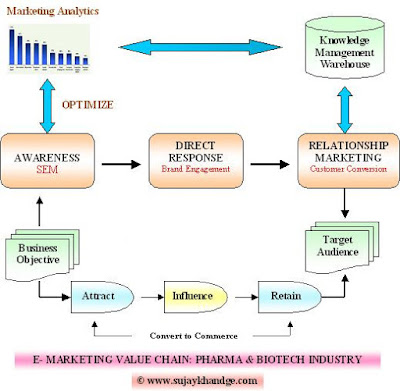The Internet Marketing Value Chain can be segmented into three stages: Awareness, Direct Response (demand generation), and Relationship Marketing. These stages, which are controlled by the analytic performed by the marketer, are managed independently and powered by the analytic engine.

Awareness:
In this stage, Internet marketers strive to build recognition and relationships with their target audience, hoping to persuade them into buying. The audience can be engaged via many modes, such as text, audio, video, and interactive (e.g., games and assessments). Each awareness opportunity can be personalized based on factors including preexisting data on the audience, context, and specific behaviors exhibited during a session. Most sophisticated Internet marketing awareness campaigns include a direct response element that lets a visitor move further into a relationship with the advertiser. This mixed mode (simultaneous awareness and direct response) is one of the strengths of Internet advertising.
As a visitor engages with an Internet message, a great deal of data is generated, such as which message engaged the visitor and the subsequent activity of that visitor. The data presents great insight into how each audience segment responds to the brand’s message.
Direct Response:
This stage involves moving a visitor into a deeper level of engagement (e.g., registration, downloading a coupon, requesting a salesperson, or providing profile information). A campaign can simultaneously offer multiple levels of engagement that match the steps in the advertiser’s marketing process. A typical direct response campaign has the following elements:
- Advertising component (banner, acquiring e-mail lists, contextual placement, co registration, and/or sponsorship)
- Conversion component (rich media banner, micro site, and/or partner site)
- Call to action (registration and/or coupon download)
The data derived from a direct response program provides insight into campaign ROI. For example, marketers will measure the whole cost of delivering a coupon download from awareness through direct response into relationship marketing.
Relationship Marketing:
E-mail-based relationship marketing (RM) is the ongoing communication with an audience that has selected to opt in to a campaign for awareness and direct response purposes. RM utilizes the direct response opt-in database to engage visitors after a session. The e-mail touch points are designed to move the audience to a deeper level of engagement. For example, if a qualified visitor registers on an unbranded site for a pharmaceutical drug, a subsequent RM e-mail may invite the visitor to a coupon offer on a branded site. Follow-up RM e-mails would then encourage coupon redemption as well as suggestions on how to discuss with a doctor whether the therapy is appropriate.
Many studies have shown that the more personalized the RM email, the greater the likelihood of success in moving the visitor to the next level of brand engagement. This means that while an opt-in database is necessary, insight into a specific visitor’s psychographics, demographic, and behavioral profile will greatly improve marketing effectiveness.
Marketing Analytic:
Marketing analytic provides the overarching framework for understanding how a specific Internet marketing strategy is resonating with a given target audience. At the aggregate level, analytic provide insight into how the awareness, direct response, and relationship marketing programs are working. In addition, analytic show the audience segments that are and are not engaged, and the resulting economic and quality metrics being realized. Analytic inform major decisions, such as advertising spend and messaging, along with tactical elements, such as the RM segments to target and the types of offers that are working.
Three types of analytic databases are developed within a campaign: psycho-graphics, demographic, and behavioral. These databases can be used separately or combined to analyze questions such as how many people 45 and older (demographic) who are not currently being treated (psychographics) viewed a specific physician video on a health site (behavioral) and became a patient.
Typical analytic questions are efficiency (how to reduce cost per action), effectiveness (how to increase quality or quantity of resulting patients in terms of persist-ency), and competitiveness (how does an advertiser’s campaign compare with others in the industry or competition). Analytic seek to understand the customer’s behavior so that it can be changed or exploited by relationship marketing
